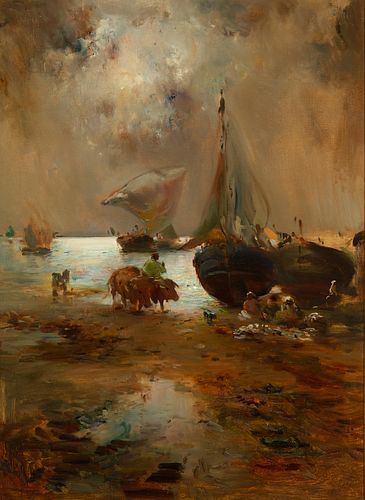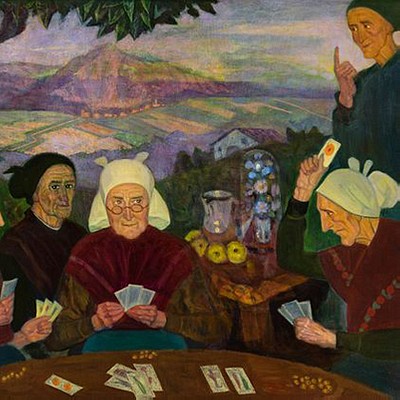JOSÉ NAVARRO LLORENS (Valencia, 1867 - 1923). "Beach with fishermen". Oil on canvas.
Lot 102
About Seller
Setdart Auction House
Carrer Aragó 346
Barcelona
Spain
Setdart Subastas was born in 2004 and is currently the first online art auction in Spain with solidity, prestige and reliability guaranteed by our more than 60,000 users. Setdart has a young, dynamic and enterprising team ready to successfully manage the purchase and sale of art works through custom...Read more
Estimate:
EUR€8,000 - EUR€10,000
$8,333.33 - $10,416.67
Absentee vs Live bid
Two ways to bid:
- Leave a max absentee bid and the platform will bid on your behalf up to your maximum bid during the live auction.
- Bid live during the auction and your bids will be submitted real-time to the auctioneer.
Bid Increments
| Price | Bid Increment |
|---|---|
| EUR€0 | EUR€10 |
| EUR€200 | EUR€25 |
| EUR€500 | EUR€50 |
| EUR€1,000 | EUR€100 |
| EUR€3,000 | EUR€200 |
| EUR€5,000 | EUR€500 |
| EUR€10,000 | EUR€1,000 |
| EUR€20,000 | EUR€2,000 |
| EUR€50,000 | EUR€5,000 |
About Auction
By Setdart Auction House
Dec 14, 2021
Set Reminder
2021-12-14 08:00:00
2021-12-14 08:00:00
America/New_York
Bidsquare
Bidsquare : 19th & 20th Century Fine Art
https://www.bidsquare.com/auctions/setdart-auction-house/19th-20th-century-fine-art-7992
Gaudi, Sorolla, Torres Garcia, Maclet, TSUGUHARU FOUJITA, Benjamin Palencia Setdart Auction House sofia@setdart.com
Gaudi, Sorolla, Torres Garcia, Maclet, TSUGUHARU FOUJITA, Benjamin Palencia Setdart Auction House sofia@setdart.com
- Lot Description
JOSÉ NAVARRO LLORENS (Valencia, 1867 - 1923). "Beach with fishermen". Oil on canvas. Signed in the lower left corner. Measurements: 78 x 58 cm; 99 x 79 cm (frame). José Navarro Llorens was very early on his way to painting, and he studied at the School of Fine Arts of San Carlos, in his hometown. After his student period we lose track of him, and we will not find him again until 1895 when, according to Pantorba, he participated for the first and only time in the National Exhibition of Fine Arts, obtaining an honorary mention. It seems that Navarro never intended to project his work beyond a limited local scope, as can be deduced from the fact that, in his early years, he devoted himself to painting costumbrista and gallant scenes for fans. Nevertheless, his early works show a certain influence of the style of Mariano Fortuny, whom Navarro admired, and from whose example he may have been inspired to travel to Morocco in a second stage. This trip must have taken place shortly after finishing his studies, and he devoted himself to painting local, North African and Orientalist themes, such as the one we present here. At the beginning of the 20th century he was hired to decorate a palace in Buenos Aires, although Navarro never arrived in Argentina. He embarked with such a destination, but during a stopover in Rio de Janeiro the painter decided to stay there indefinitely. In the Brazilian city he continued to work and held an exhibition that was widely celebrated. However, nostalgia for his homeland, the absolute protagonist of his pictorial language, led him to return to Valencia, settling in Godella permanently. There he lived the rest of his life in a simple and humble way, giving painting classes at the town's Academy and painting tirelessly. His style draws from various influences, such as Fortuny, Domingo Marqués or Levantine luminism, but it was always deeply personal, linked to Navarrete's own way of understanding the world. His painting refers to Mediterranean clarity through beautiful transparencies, a corporeal luminosity and nervous and vibrant brushstrokes. His is an energetic, robust and vital realism, which turns light into a plastic and even tactile value, more than a chromatic one. José Navarro is represented in the Fine Arts Museums of Valencia and Asturias, as well as in the Gerstenmaier collection.
- Shipping Info
-
In-house shipping available. Please inquire at admin@setdart.com.
-
- Buyer's Premium



 EUR
EUR CAD
CAD AUD
AUD GBP
GBP MXN
MXN HKD
HKD CNY
CNY MYR
MYR SEK
SEK SGD
SGD CHF
CHF THB
THB















